When your company has exciting news, you want to shout it from the rooftops. You want to reach your target market, create a buzz about your product, and leave your audience eager to know more. But with so many ways to reach people, it can be confusing to know where to start. Should you post it on social media? Publish a news or press release? Or contact the media with a story. You’ll likely need a news release if you want to go big. While “news release” and “press release” are often used interchangeably, they differ. Both announce new, significant information, but there are some important differences. In this article, we will discuss what a news release is, how to write one, and some unique differences between a press release.
Key Points
- A press release, news release, media release, or press statement is a written or recorded communication for news reporters.
- A news release could cover topics such as politics, crime reporting, or wholesome stories about good Samaritans.
- These are the different types of news releases, including product launches, events, social & environmental initiatives, rebranding, and new hires.
- A news release covers something currently or has already happened, and a press release covers something that has yet to happen.
What Is a News Release?
A news release is a short informational statement that can be provided in written or verbal form. They can be provided by businesses, governments, or other organizations, and are important for informing the public about events or products related to the organization.
News releases might be published on an organization’s website, shared on social media, sent via newsletters, or distributed through other channels. While they may contain newsworthy information, they aren’t always written in a journalistic style like a press release.
What Is the Purpose of a News Release?
A news release aims to inform an audience of events happening around them from an unbiased perspective.
A news release could cover topics such as politics, crime reporting, or wholesome stories about good samaritans. To have your news release reach the right people, you must write for your target audience.
Although these bits of information may seem inconsequential, they could mean the difference between gaining and losing readers. For example, millennials tend to gravitate towards certain formats to receive current news compared to baby boomers, particularly regarding political-related news.
You may want to make a news release for your small business if your business was recently involved with a local event, such as a charity run or if your business recently changed its hours of operation.
Types of News Releases
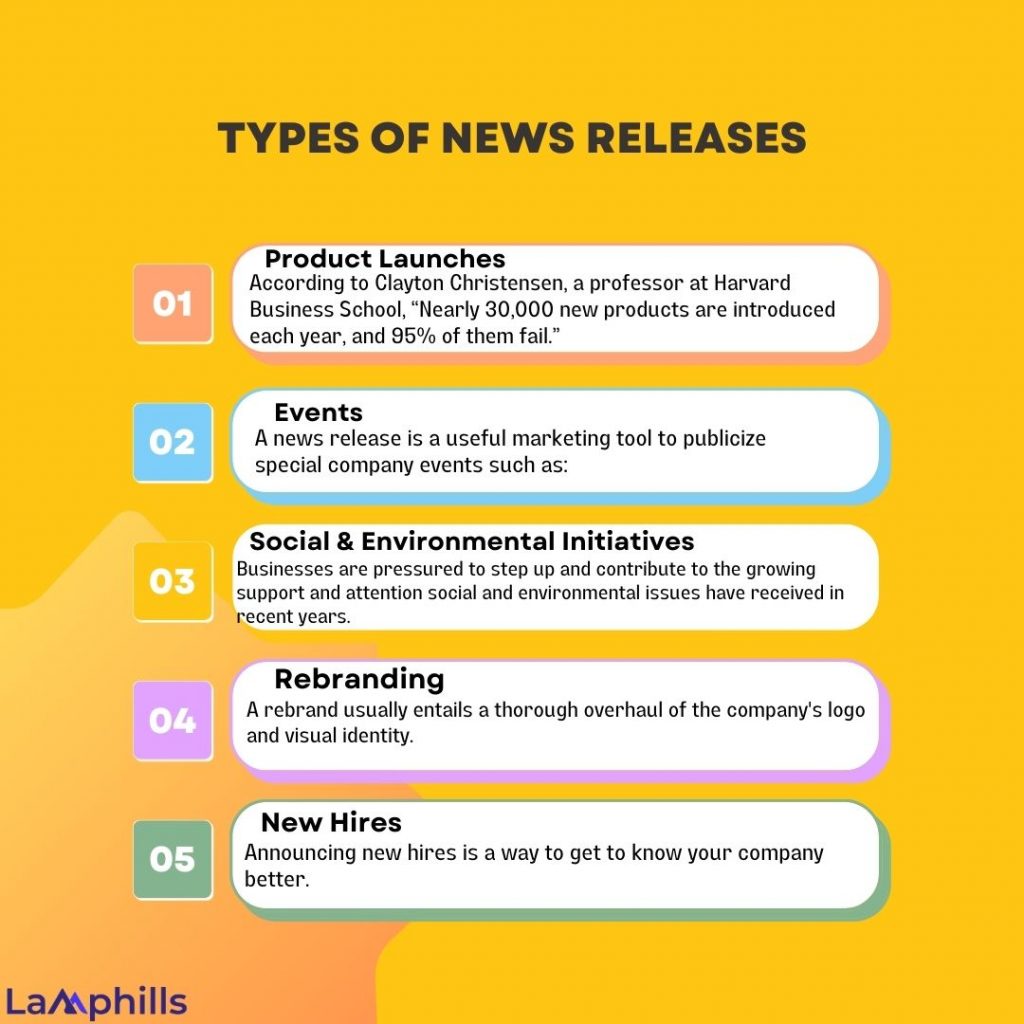
With fake news and misinformation plaguing our newsfeeds daily, studies show that media still rely on the news release as a credible source of information and a fact-checking resource.
As an important component of your marketing toolkit, news releases can be used to deliver all types of organizational news and updates. Whether for branding purposes, to announce important company developments or as part of a public relations campaign, news releases help your brand build a positive relationship with the media and public.
Here are different types of news releases and how to use them in your marketing efforts.
#1. Product Launches
According to Clayton Christensen, a professor at Harvard Business School, “Nearly 30,000 new products are introduced each year, and 95% of them fail.” Many reasons contribute to the high failure rate, but creating sufficient awareness and interest is vital to jumpstarting sales and ensuring a successful launch.
A news release is an effective way to promote the launch of a new product. To create interest and engagement, the release should highlight unique features of the product with specific details on pricing and accessibility, and prompt the reader to find out more or visit the store.
Essential content that should be included:
- The product’s special features, especially those unique from its competitors
- New or innovative technology used
- Who would benefit most from the product
- What problems does the product solve
- How the product makes life easier or better for users
- Different versions of the product and the price range
In addition, when providing pre-order incentives or a brief discount, include trackable links to the product launch landing page so you can assess how well the news release piques interest and prompts action.
#2. Events
A news release is a useful marketing tool to publicize special company events such as:
- New product or service launches
- Corporate retreats
- Charity initiatives such as marathons and auction fundraisers
- Press conferences for business announcements
- Exclusive VIP events
- Community-centric activities such as blood drives, tree-planting, etc
Issuing an event news release helps you build media exposure before and after the event for brand visibility and to create positive public relations.
The following information should be included in the news release:
- The purpose of the event and why it’s important
- Date, time, and venue
- Type of event: private or public
- If it’s a public event, specify who should attend and how
- Highlights of the event program, including special guests
- Contact information for media and public inquiries about the event
#3. Social & Environmental Initiatives
Businesses are pressured to step up and contribute to the growing support and attention social and environmental issues have received in recent years.
Supporting social or environmental activities is a fantastic approach to make a difference and establish a positive brand image. Examples of these initiatives include migrating towards a carbon-free business model and fostering a more open, varied, and inclusive working environment. This is the kind of positive news that regular people would be more interested in sharing.
That being said, to guarantee the credibility and transparency of your endeavours, it is imperative that your news release convey the news in an impartial and reputable way.
Include the following facts and information in your news release:
- How you will implement your initiative(s) and ensure its integrity
- Valid research that shows a need for your initiative
- Quotes from the company’s management on why the initiative is important
- Contact details for the person in charge of the program
- The motivation for your initiative
- The scope of your program and specifics on how it will benefit the community or environment.
#4. Rebranding
A rebrand usually entails a thorough overhaul of the company’s logo and visual identity. It could be the outcome of internal reorganization or a move to realign the brand with a new strategy. Whatever the motivation for rebranding, it’s a big enough transformation to merit a news release informing the brand’s stakeholders of the change.
Educating your customers and the public about your rebranding campaign takes a certain amount of effort, which makes it imperative to communicate the change clearly and confidently. The news release should include information on the changes, the rationale behind the rebrand, and how the move will help or impact people.
To create a positive buzz around your rebrand, include the following in your news release:
- An engaging story that explains the reason for the rebrand and why it’s necessary
- How the rebranding exercise helps the company and its stakeholders, including its employees and customers
- The new brand name, direction, vision, and values, as well as the inspiration behind it
- The extent of the rebrand and what exactly will be different
- Visual representations of the new brand identity and aesthetics versus the old (e.g. logo, website design, storefront identity, colour palette, tagline, etc)
- The PR or creative agency managing the rebranding campaign
- When the rebranding takes effect
- A link to an online presskit with high-resolution files of the new brand assets
- A contact person to whom the media and public can address their queries to
#5. New Hires
Announcing new hires is a way to get to know your company better. Who works for you and their experiences illustrate your company’s or business’ values at work, and will also give your clients and audience an idea of who they are, their expertise, and what they bring to the table.
This news release is on point and concise but still includes relevant quotes, visuals like photos, and newsworthy information about them.
This new hire PR from eBay shows us how it’s done: concise and straightforward, yet still has everything you need to know about him.
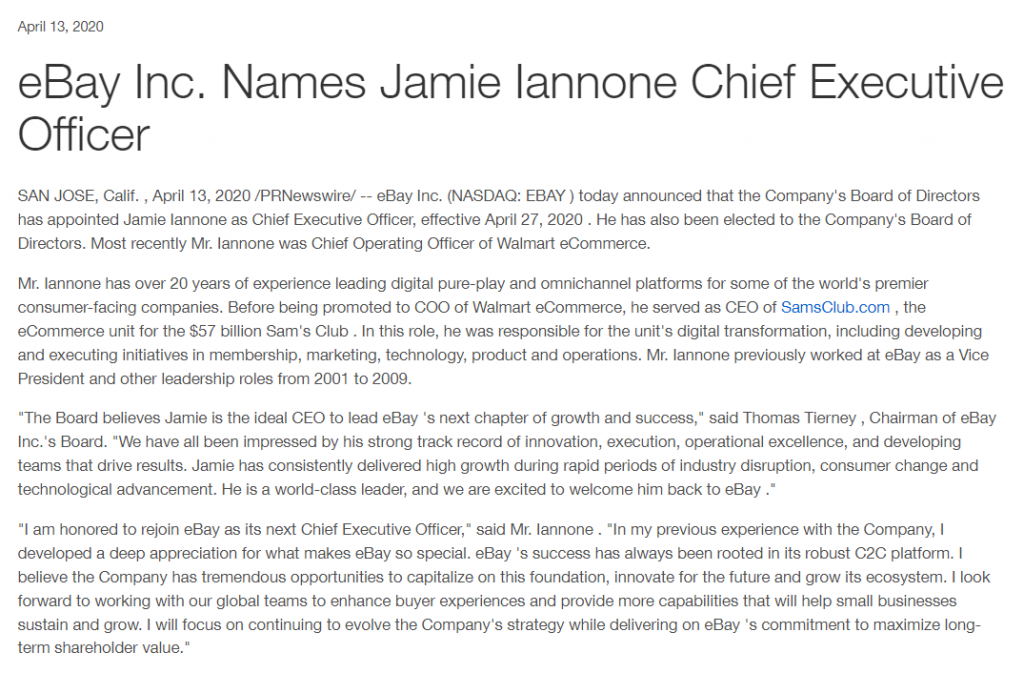
Quotes from the newly appointed CEO and the company’s board chairperson show how much they value good leadership, and bits about the new hire make the clients and audience understand why they can trust the company more.
How to Write a News Release
Having worked with an experienced public relations specialist, I can attest to the importance of creating news releases that have an impact. I deeply understand the details of successful communication in the dynamic media landscape.
Hence, below is a comprehensive guide to help you effectively write your news release.
#1. Evaluate the Topic
The first step is acknowledging and evaluating whether the news release’s topic or angle is relevant to the target media.
Is this the same kind of story the journalist covers regularly? Would the journalist’s readers gain any benefit from knowing this information?
Standard news release topics include new product launches, mergers and acquisitions, product updates, events, grand openings, new partnerships, rebranding, executive promotions/hirings, industry awards, and more.
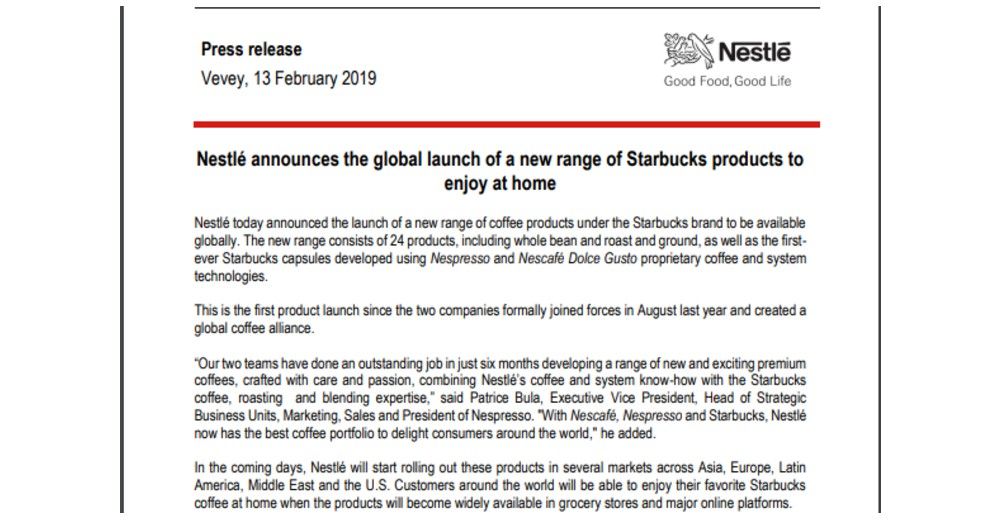
The above news release is an excellent example of a product launch announcement that would cater to consumer-centric media. Business journalists may also glean some value by examining the partnership.
#2. Write a Clear Headline
The news release headline is the part that you hope will appear on the front page of the news outlet. Therefore, the headline must be clear, captivating, jargon-free, and focused on the key message you want to convey.
Ideally, by only reading your headline, the journalists (and the readers) can get the entire idea of what the news is all about.

The above news release hits the mark in this respect. It is clear and concise. By only reading the headline, the audience immediately knows the advantages of the new golf ball.
Most importantly, the brand’s unique selling points appear in the headline. So, if readers decide to click away from the news without reading further, the message has still effectively been delivered.
#3. Include Important Details in the Opening Paragraph
The news release’s opening paragraph should address the 5W+1H questions (who, what, where, when, why, and how) after the headline. The average person’s attention span these days is only about eight seconds.
It’s important to deliver all the key information right away. If you put crucial information after this section (e.g. burying the lead), there’s a greater chance readers will miss it.
In short, your press release flow should follow the “reverse pyramid” formula:
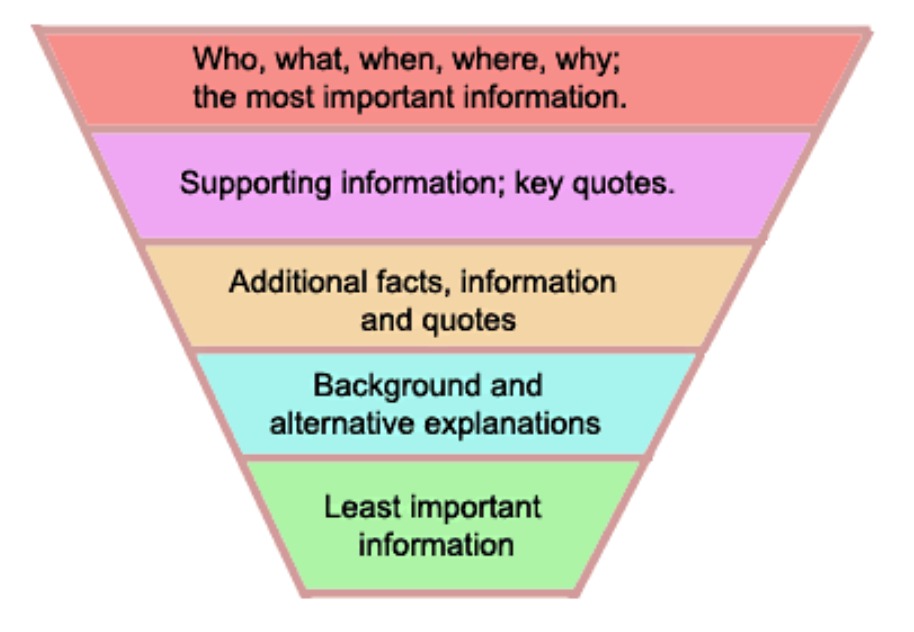
#4. Include an Overview of the News Release
Important bullet points before the first paragraph are a terrific method to “hook” journalists’ attention. The news is intended to be summarized in the bullet points.
When it is viewed by busy journalists, they will be able to quickly assimilate all of the release’s key themes and determine whether or not to pursue the topic further. Since bullet points allow readers to scan quickly, you should include all pertinent information, including numbers, in this area.
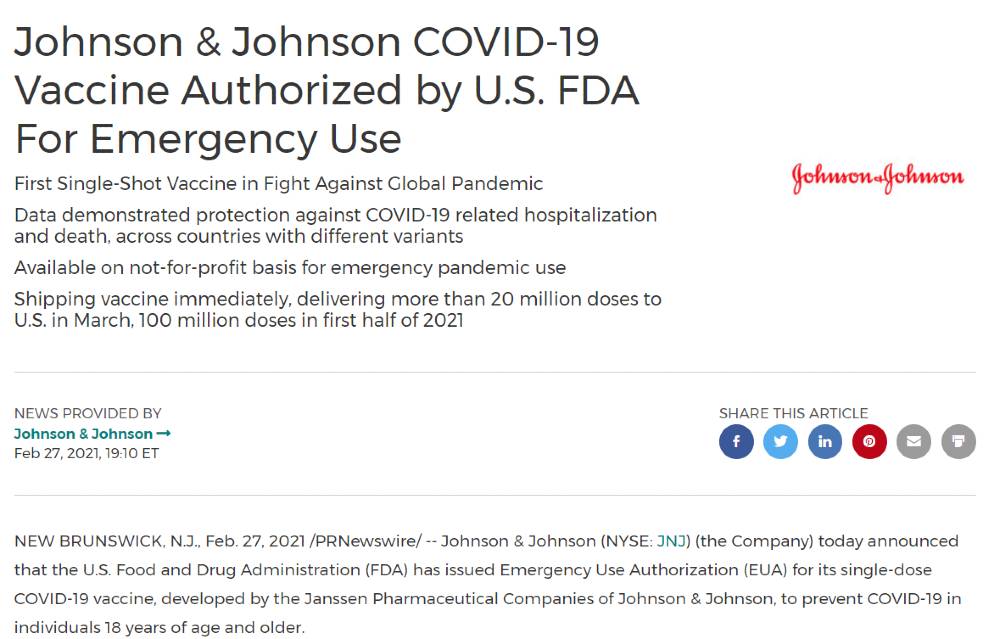
As you can see, Johnson & Johnson’s press release uses clear, straightforward bullet points so that readers can grasp all the key information before reading further. Announcing the new vaccine launch, J&J answers most of the anticipated questions, such as the USP (first single-shot vaccine), supporting data, and availability.
#5. Insert Quotes
Outstanding news releases are always accompanied by thoughtful, pertinent statements from spokespersons.
The media is generally eager to hear from specialists, well-known people, respected organizations, and business executives. Ensure to include quotes from reliable sources on the brand side to bolster the legitimacy of your announcement.
Take advantage of this and ensure that when you announce a business update, at least one executive from the company is featured. Meanwhile, quotes from all pertinent parties should ideally be included when promoting a new collaboration with other parties.
#6. Utilize Information
Make your news release captivating by including background information about the subject. You can accomplish half of the work for the journalist by outlining the industry landscape for them upfront. Though it’s sometimes disregarded, providing this kind of information is one of the simplest ways to make your release appear less blatantly promotional and more grounded.
For example, it’s a good idea to provide evidence when introducing a new food product designed only for children, such as market potential, trends in adolescent snacking, and common issues that parents deal with.
Another way to add value to your news release is by ‘newsjacking,’ or relating your announcement to current events.
Free News Release Template
Lamphills News Release Template
News Release Examples
News releases are an effective tool for businesses and brands who need to use the media to reach the public. They enlighten the public about a brand’s most recent business decisions, especially those that will affect the business and its clients.
Pro tip: Businesses should make sure that their updates and announcements are newsworthy and not just routine business affairs, as the media is the one that takes a news release and turns it into a narrative.
Embargoed News Release Example
Below are examples of when embargoes have been used for impactful news items.
- In a few countries, including Australia and Canada, embargoes are in place surrounding the release of government announcements. This means that journalists have access to government decisions ahead of the general public, meaning that they’re able to prepare their stories but not able to share the updates publicly until the official announcement by government members or representatives has taken place.
- The UK’s Ministry of Defense shared the news that Prince Harry would be serving in Afghanistan with several news outlets before his deployment, on the condition that the story wasn’t released until his deployment ended. While the information was later leaked, this embargo was put in place for Harry and his fellow soldiers’ safety.
- An embargo surrounded George W Bush’s visit to Iraq in 2003. The journalists accompanying him were embargoed until he safely visited and left the country. The journalists were informed that Bush’s trip would need to be canceled to protect his safety if the embargo terms were broken.
- Some press briefings are regularly embargoed. The biweekly briefings from the International Monetary Fund are embargoed until the same time each fortnight. Due to the impact the information shared can have on global stock markets, updates are collated and released consistently, rather than day by day.
- Apple makes users of embargoed news releases to maximize media attention around the world post-announcement of a new product
Sports News Release Example
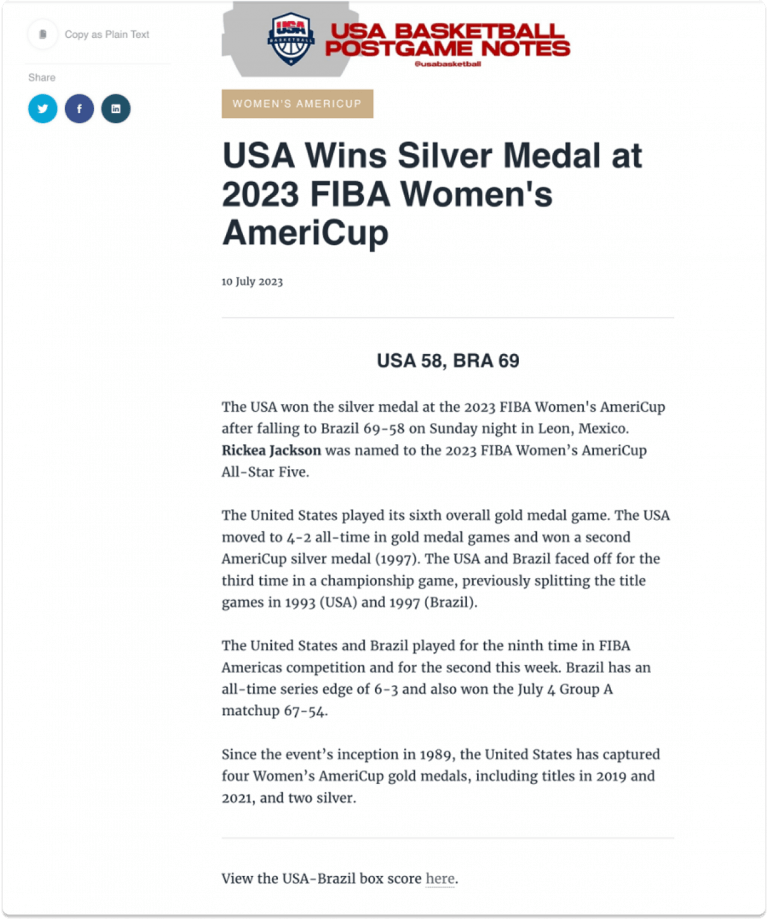
In this news release, the USA Basketball team reveals their victorious silver medal achievement at the 2023 FIBA Women’s AmeriCup.
This sports press release offers a captivating overview of the team’s performance, game highlights, and coach quotes praising the team’s efforts while acknowledging areas for improvement.
News Release Vs Press Release: Differences
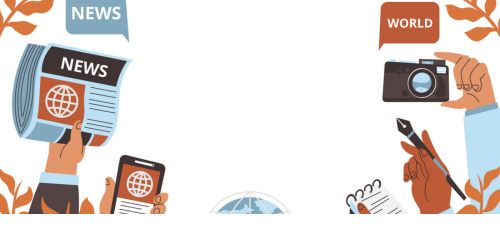
While news and press releases aim to enlighten the public and the media, there are several key distinctions between the two.
#1. Tone and Style
Press releases frequently have a more promotional or marketing tone, emphasizing the organization’s accomplishments, products, or main points. On the other hand, news releases maintain an impartial tone while concentrating only on conveying news material and avoiding overt promotional language.
#2. Content Focus
Press releases are intended to draw attention to certain achievements of a business or organization, such as new product launches, milestones for the company, partnerships, or honors. They frequently use statements from company leaders or spokespeople to provide a human touch. On the other hand, news releases prioritize providing news-related information, such as breaking news, market trends, scientific discoveries, or community involvement.
#3. Audience
The primary audience for news releases is journalists, editors, and news outlets. These releases provide reporters with accurate and timely information to craft news stories. Press releases have a broader audience, including journalists, bloggers, consumers, and potential clients or customers. They aim to generate interest and engagement from the general public and media professionals.
#4. Call to Action
News releases do not typically include a call to action (CTA) because they aim to inform. The objective is to provide information to journalists so they can develop their own stories. Press releases often include a CTA, urging readers to take specific actions. This may involve visiting a website, purchasing, attending an event, or contacting the organization for more information.
Benefits of News Release
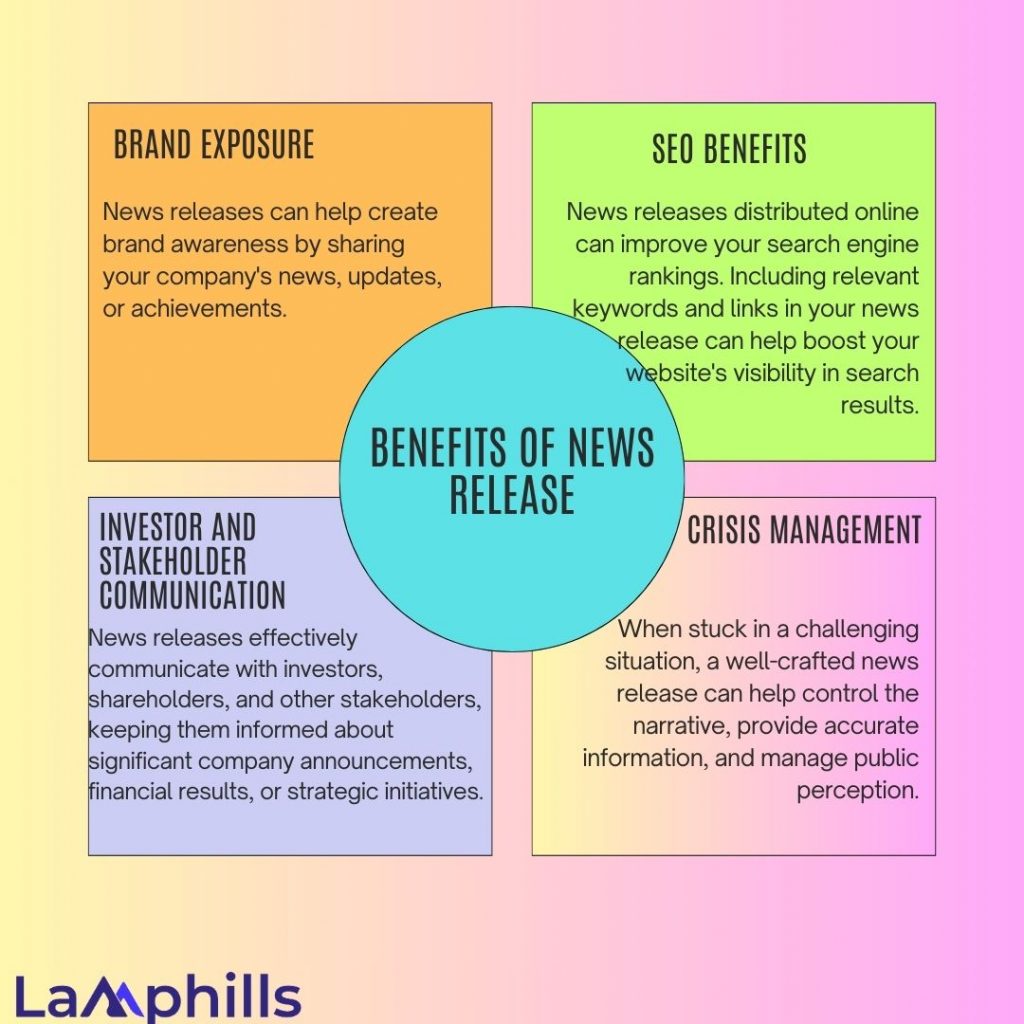
Aside from helping your company generate media coverage, news releases offer several benefits.
- Brand exposure: News releases can help create brand awareness by sharing your company’s news, updates, or achievements. This exposure can attract potential customers and increase brand recognition.
- SEO benefits: News releases distributed online can improve your search engine rankings. Including relevant keywords and links in your news release can help boost your website’s visibility in search results.
- Investor and stakeholder communication: News releases are an effective way to communicate with investors, shareholders, and other stakeholders, keeping them informed about significant company announcements, financial results, or strategic initiatives.
- Crisis management: When stuck in a challenging situation, a well-crafted news release can help control the narrative, provide accurate information, and manage public perception.
Bottom Line
To keep your PR approach fresh, you must set aside preconceived ideas about public relations and concentrate instead on producing extremely impressive content. Make releases more relevant for your marketing by giving them an innovative makeover rather than discarding them as a strategy.
By utilizing inbound strategies, examine how you have adapted your marketing strategies to be more relationship-building, individualized, and approachable. Your PR strategy should follow these guidelines: Create content to tell your story and employ strategic PR to introduce and pique the media’s interest in your company.
Related Articles
- RELEASE MANAGEMENT: Meaning, Process, Duties, Salary, & Software
- PR IN BUSINESS: Types, Functions and Benefits
- HOW TO WRITE A MANIFESTO: The Ultimate Guide






